 8
8

The mystery of the stone walls of Sacsayhuaman
 15. 04. 2024
15. 04. 2024



 23. 06. 2020
23. 06. 2020

All over the world, there are important prehistoric sacred places that testify to the faith and the ways in which it was expressed by the people of that time. Some are very old, up to 12 years, others are much younger. There is also an inexhaustible number of theories and interpretations of their true purpose. However, few people know that similar shrines were located in our territory, especially in southern Moravia and in the fertile part of the Czech Elbe and Povltava. Let's take a closer look at them and get to know the spiritual world of our ancestors.
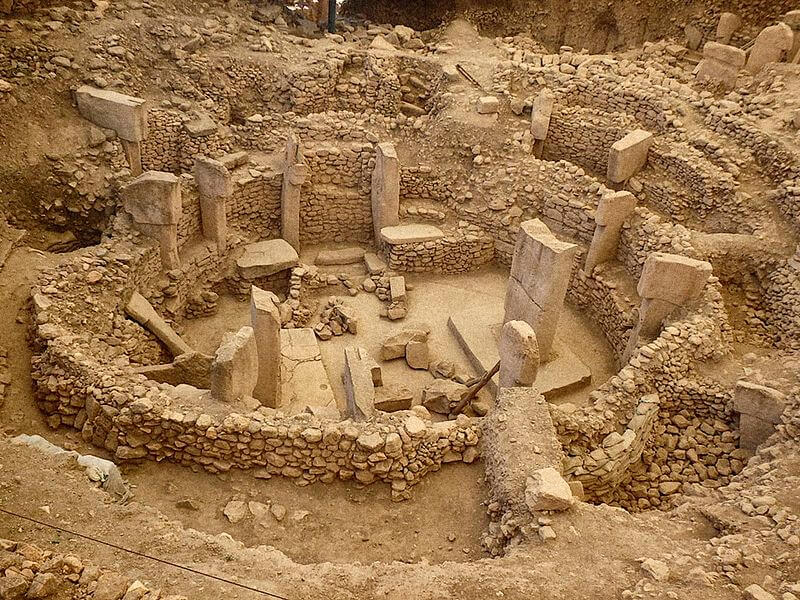
Göbekli Tepe
However, before we go into the prehistory of the Czech lands, it would be good to remember some well-known circular buildings in Europe and the Far East, which can help us understand not only the origin of shrines from our territory, but shed a little more light on knowledge of their true purpose and meaning.
The oldest circular shrine discovered so far can undoubtedly be considered a group of stone circles in Göbekli Tepe in today's southeastern Turkey. Archaeologists discovered a building on this hill in the 90s that significantly confused ideas about the prehistoric development of mankind. Its dating dates back to 20 BC and precedes the emergence of agriculture, which, according to earlier theories, should have been a prerequisite for the emergence of monumental buildings. It even seems that it was the activity in Göbekli Tepe that led to the emergence of agriculture, because only a few kilometers away is a place where the origin of important cereals, especially wheat, can be genetically localized.
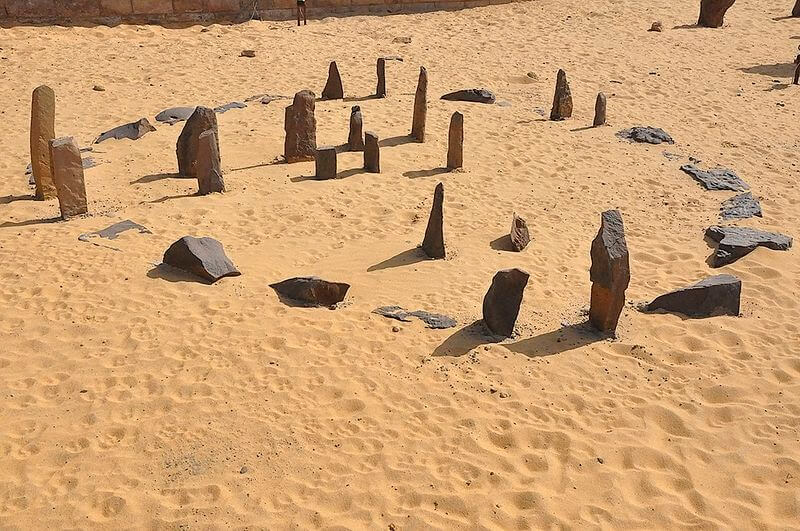
Stone circle at Nabta Playa in Egypt
So what did archaeologists actually discover? Göbekli Tepe consists of several stone circles built of megalithic pieces of stone, in the center of which there are typical T-shaped pillars. message of an ancient catastrophe.
A remarkable stone circle was also discovered in Egypt and was erected long before the first pharaoh ascended the throne. On the desert plain of Nabta Playa in southern Egypt, almost on the border with Sudan, there is a circle of stones, which were very ingeniously placed by prehistoric people sometime around 5000 BC, and their distribution shows significant astronomical knowledge of ancient people. The individual lines formed by the stones are oriented to the stars Sirius, Arcturus, Alpha Centauri and to the stars in the Orion Belt, ie the same stars that later had a direct sacred meaning in the Egyptian religion. It should also be noted that the Sahara at that time was not an arid desert, as it is today, but a savannah inhabited by a large number of animals - buffaloes, elephants, antelopes and giraffes - as well as humans.
When you say a prehistoric circular shrine, most people immediately think of Stonehenge. However, this South English prehistoric site of world importance is much younger than buildings from Central Europe and its origins can be dated to around 3100 BC. However, it seems to be a continuation of a significant tradition that came to the islands from the continent. This stone circle has a clear astronomical orientation, the most important of which is the solstice. The development of Stonehenge itself is long and the whole building has changed its appearance over the centuries. Moreover, it was not alone. The whole landscape around Stonehenge is directly dotted with prehistoric monuments, whether they are tombs, fences, processions or other shrines.
The Tomb of Newgrange in Eastern Ireland is also slightly older than Stonehenge. This remarkable monument once again proves the ingenuity and astronomical knowledge of prehistoric people, because during the winter solstice a ray of light penetrates into the interior of the tomb and illuminates a stone decorated with engravings of spirals. Newgrange is part of a complex of megalithic monuments in Brú na Bóinne, of which the Knowth Tomb, which itself contains more than a quarter of the megalithic art of Western Europe, should be highlighted.
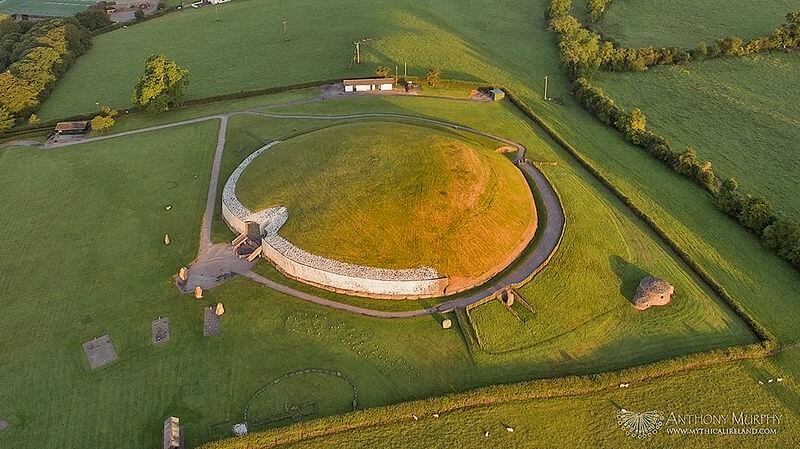
Tomb of Newgrange in Ireland
The Neolithic way of life, based on agriculture and cattle grazing, entered Central Europe around 5500 BC from the Balkans along the Danube. These first farmers were already fully adapted to life in the temperate zone, building long stake houses and making cut stone axes and pottery decorated with lines, often twisted into spirals, which experts call a culture of linear pottery. It was followed by people with ceramics decorated with patterns formed by small punctures arranged in complex shapes, mostly zigzags. Manifestations of the spiritual life of both these cultures were small statues of women and animals and the characteristic decoration of the vessels, and although moat and palisade enclosures sometimes appear, they were more of defensive structures. It was only the people of the Lengyel culture, called the culture of Moravian painted pottery in our country, which with it around 4800 BC from the Carpathian Basin brought the tradition of building complex circular ditch fences, usually with four entrances - roundels.
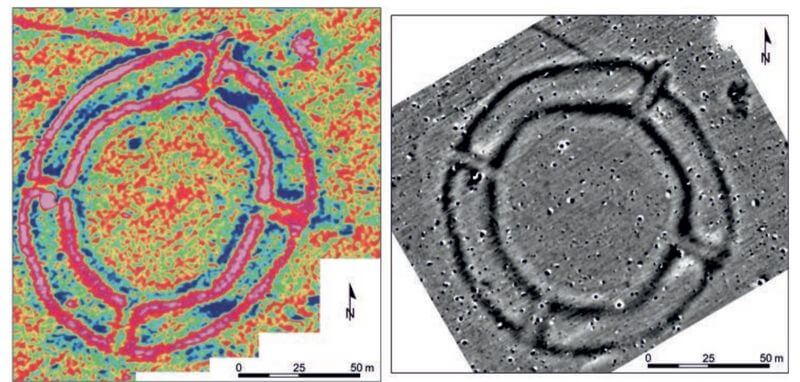
Geomagnetic map of the roundel in Milovice, okr. Břeclav.
The construction of the roundels consisted of several important elements: a moat, entrances, a palisade and a possible rampart located outside the moat. The ditches, whether single or multiple, were arranged in a circle and interrupted in four places. This created entrances to the sacred space, which were usually oriented according to the sides of the world, or according to important astronomical phenomena such as sunrise at the solstice or the equinox in the landscape. The dimensions of the roundels vary from small, about 40-70 m in diameter to gigantic with a diameter of more than 250 m. The ditches were usually deep and always essentially in the shape of the letter V. The significance of this specific shape could be that water easily collected in it and thus created a kind of moat, which had its significance in the cosmology of this people.
A number of roundels were also shown to be enclosed by a palisade, which even more consistently separated the sacred space from the surrounding space. At the roundabout in Těšetice in the Znojmo region, such a palisade also defined a wider circle around the roundabout, in which, among other things, there was a common grain silo. The separation of the sacred space from the surrounding world is also related to the possible existence of ramparts on the outer sides of the moats. An interesting example can be a roundel from East Bohemian Třebovětice, where such ramparts have been preserved. Unfortunately, this is the only such case in the Czech Republic, as the landscape has been significantly altered over the centuries by human activities and most of the ramparts, mounds and other above-ground monuments of ancient civilizations have been irretrievably lost.
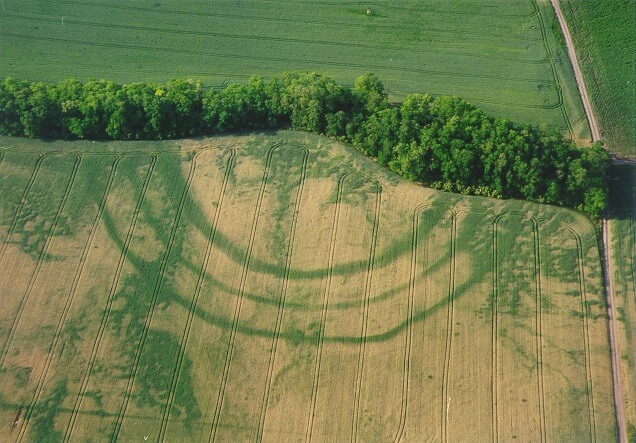
Vegetation symptoms, thanks to which it is possible to see the outline of the roundel in Hrušovany, okr. Znojmo. The difference in the color of the stand is due to the permeability and nutritional value of the soil, which is higher in prehistoric ditches.
The space of the roundel itself was usually empty, except for a few pits hiding possible sacrifices or serving as a base for stakes depicting deities or sacred totem animals. Only in exceptional cases can there be evidence of the existence of a stake building inside the complex - perhaps some form of shrine or the residence of a priestess / shaman. This was the case, for example, in the Bulgarians in the Břeclav region or in the Slovak towns of Bučany.
Who were the rondel builders? In Moravia, it was mainly people coming from the Carpathian Basin, whose pottery was richly decorated with paintings. In Bohemia, the people following the original tradition of decorating their pottery were pricked, the so-called culture with spiked pottery, which took over the practice of building roundels from the above-mentioned people of Moravian painted pottery.
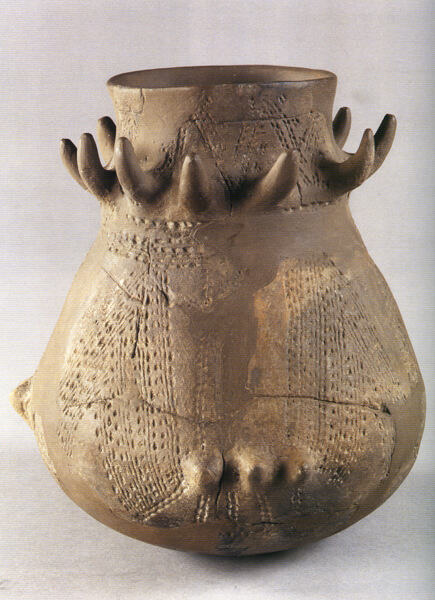
Culture vessel with spiked ceramics.
Wheat cultivation and cattle breeding, especially goats, sheep, cows and pigs, were essential for both cultures. The use of stone for the production of tools was also common. They made various blades, sickles or leather processing tools from easily split materials such as flint or rare obsidian. More massive raw materials, such as metabasite from the Jizera Mountains, were processed by grinding into axes, teslas, ax-hammers and wedges.
Here, however, the similarity of these cultures ends. Apart from the most striking difference in the decoration of ceramics, which I will discuss in more detail below, they differed, for example, in the way of living and the material manifestations of spiritual life. The way of living the culture followed with a continuation of the older tradition of building long houses, but the Lengyel culture brought with it to Moravia the habit of building smaller dwellings, which at the same time express a change in the organization of society. While long houses are associated with a large family, ie several generations and a wider family living in one dwelling, Lengyel houses are considered to be arranged in paired families, a way of life closer to ours.
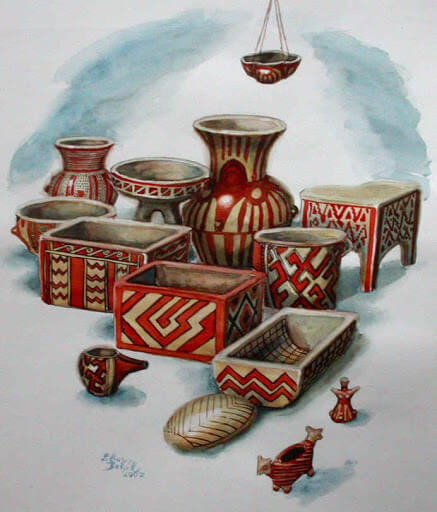
A set of vessels of Moravian painted pottery culture. Author - Libor Balák
As I have already described in the article on prehistoric art and changes of consciousness, the decoration of prehistoric ceramics captured cosmological data and entoptic phenomena experienced during the altered states of consciousness accompanying various rituals. Here, too, it is possible to observe the difference between people made of pottery and members of the culture of Moravian painted pottery. The first ones in their decoration preferred the zigzag, sometimes stylized in the form of a "frog motif," which most likely symbolized the woman giving birth. Over time, of course, the decoration changed and motifs of chessboards, strips or flat decorations began to appear. The culture of Moravian painted ceramics, as can be deduced from its name, is characterized by painted decoration using mainly white, yellow, red and black. Using these colors, they created a whole range of patterns, the most popular of which were the so-called hook-shaped meanders, chessboards, zigzags and ribbons. It is remarkable that he shares many motives with the very advanced culture of Cucuteni-Tripilja from today's Romania and Ukraine.
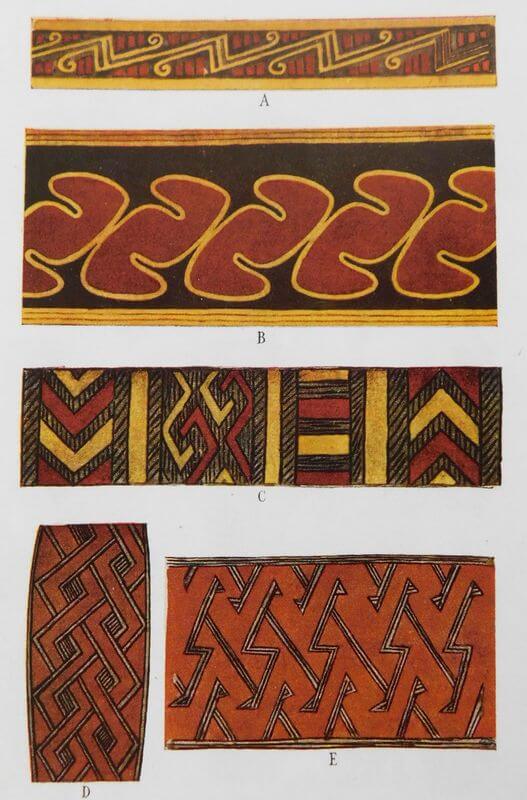
Decorative elements of vessels of Moravian painted pottery culture.
Probably the most significant difference between these two cultures are the preserved objects that can be associated with the manifestations of spiritual life. While in the culture of pottery, these objects are limited to animal figurines and some special ceramic vessels, in the culture of Moravian painted pottery we find a flood of objects related to the cult. Among them, statues of the so-called Venus stand out, which probably represented the priestesses or the personified goddess Mother. These figures are depicted in a gesture with outstretched or outstretched arms, as if incarnating or receiving spiritual power. Some of these Venus even sat on thrones expressing their sovereignty.
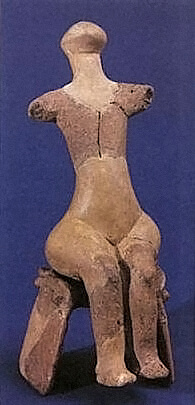
Statuette of Venus sitting on a throne from Nitranský Hrádok in Slovakia.
Their broken pieces are usually found in the area of the roundels or in their vicinity, and it is possible that the figures were intentionally destroyed in the rituals of restoration or as a surrogate victim.
Venus is accompanied by a number of other cult objects, the complete list of which would be too exhaustive. These include, for example, animal figurines, models of dwellings or various daily objects
needs. Furthermore, various ceramic boxes that could serve as lamps or incinerators, or containers for storing sacred objects. It should be added that, like vessels, these objects were usually richly decorated with paintings and engravings.
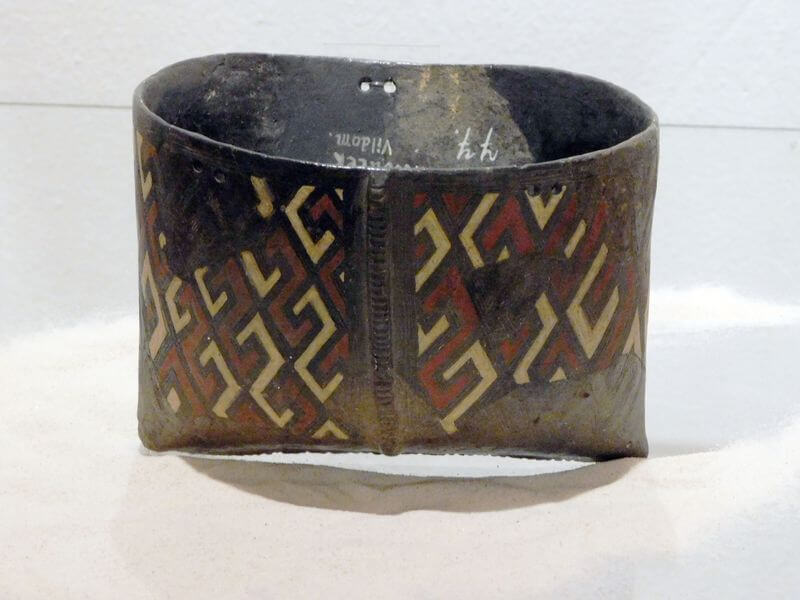
Bag model with colorful decoration.
Ceramic objects and the construction of roundels itself prove that the people of that time lived a rich spiritual life, which, however, probably intertwined with their daily activities. Life was one big ritual. But what did the spiritual world of these people look like, and is it even possible to bridge the 7000-year gap?
We must seek help here from indigenous cultures living a similar way of life and also from ancient civilizations, which managed to record the traditional way of thinking in writing. It is typical for all cultures around the world to divide the world into three basic levels: heaven, earth and the underworld. In some societies, this division is further branched, for example, in the case of the Vikings, empires inhabited by giants or elves are also known. The connection between these three levels is always provided by the axis of the world in the form of a sacred tree. It can also be transformed into a pole or a column supporting the roof. In traditional societies, such as the Barasana tribe, dwelling is a model of a world in which the roof is heaven, the floor of the earth, and beneath it hides the underworld with ancestors. All these levels are connected by the main pillar of the house.
Seen from above, this world takes the form of a circle divided into four parts according to the sides of the world, and its circumference is formed by water - a sacred river or sea. In some societies, the four sides are also assigned specific colors, for example, in the case of the original inhabitants of America, they are red, white, yellow and black, ie the same colors that are also found on the vessels of Moravian painted ceramics. Native Americans also built huge stone circles called medicine wheels, which depicted a cosmological model of the world depicting the four sides of the world, Mother Earth, Father Heaven, and the sacred tree. The medicine wheel is also a symbol of balance, eternal repetition, as well as a tool for the transmission of knowledge and traditions. It is therefore possible to say that the roundels of Central Europe had a similar function. They represented a model of a world divided into four directions symbolized by four entrances bounded by a barrier in the form of a moat, quite possibly occasionally flooded with water, in the center of which was a column of the axis of the world. Of course, this interpretation is not valid everywhere, because there are also buildings with three or, conversely, five or more entrances. However, the inputs could also be used for astronomical observations, which were important for determining important events of the year, such as solstices, equinoxes or the exits of specific stars or planets. It is also possible to orient the roundels according to the month. This idea is also supported by the direction of the entrances to the roundel in Bučany, Slovakia, which makes it possible to observe the sunset every 18 years against the saddle of the peaks of the Little Carpathians. With the help of these observations, they could easily maintain a synchronized lunisolar calendar, which helped them determine the beginning of the various stages of agricultural work, but also the important days of the year accompanied by festivities.
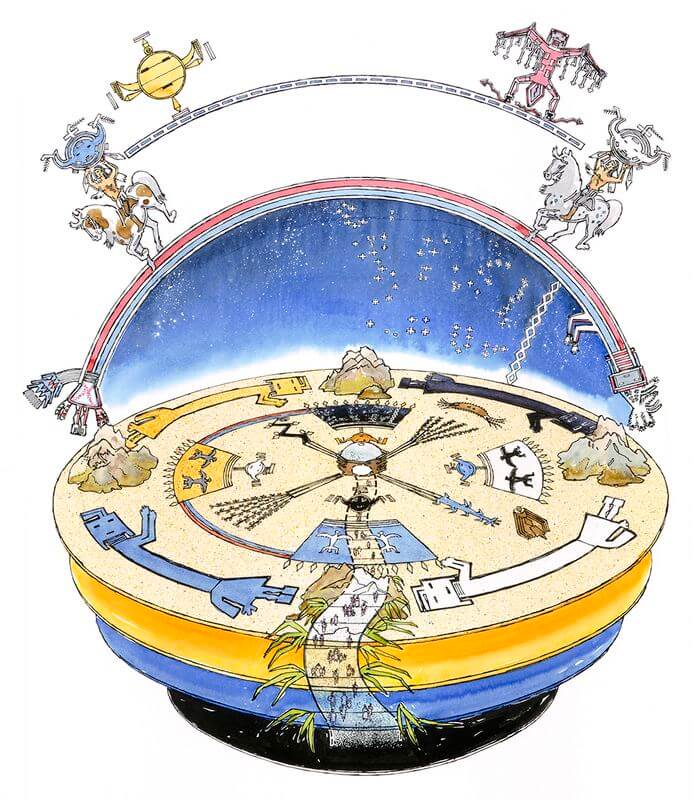
A model of the world according to the ideas of the Navaho tribe from the southwestern USA.
The much deeper meaning of the roundel lies in its function as a tool for traveling between different levels of space. Although this travel was usually reserved for priests or shamans, they could also be tasted by ordinary members of society during joint ceremonies. During ecstatic rituals accompanied by rhythmic drumming, chanting, dancing, and quite possibly the use of consciousness-altering plants, the entire community experienced strong spiritual experiences that helped maintain cohesion and strengthen awareness of tradition and its true meaning. Due to their size and location in the countryside, roundels served a larger number of communities in the area, and the rituals performed in them were also associated with strengthening relations between individual villages, arranging marriages or trade. Even their construction itself was undoubtedly the work of people from the wider area and thus provided a basis for mutual cooperation. The roundels represent the top architectural works of the Neolithic society, which was replaced by the people of the first metalworkers. With the advent of metal, people's lives changed dramatically, and the cult of the warrior, the construction of fortified settlements, and the symbolism of the bull gained in importance. The idea behind the construction of roundels subsequently manifested itself in Western Europe and gave rise to such monumental buildings as the English Stonehenge or the Irish Newgrange.